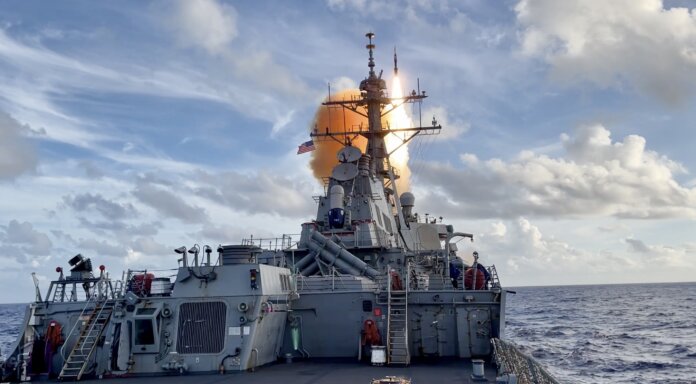
MDTF – THE MODERN DAY OODA LOOP
Dear Readers,
Returning to Association of the United States Army (AUSA) annual convention in Washington DC in October for the first time since 2019, the talk around the stands was divided between the immediacy of the unprovoked Russian attack on Ukraine which has been raging since February this year, while also looking over more distant horizons to the growing strategic rivalry that China is building.
Just before the start of the convention, the US Army announced the formation of its third Multi Domain Task Force (MDTF) – the second to be established to serve the Pacific, while the remaining MDTF is based in Europe. The MTDF’s now focused on the Pacific were established in 2017 (Washington State) and 2022 (Hawaii) respectively, while the middle MDTF was established in Germany in 2021.
The US Army Training and Doctrine Command (TRADOC) defines the MDTF as “rapid and continuous integration of all domains of warfare [so that it can] counter and defeat a near-peer adversary capable of contesting the US in all domains [air, land, maritime, space and cyberspace] in both competition and armed conflict.”
In essence, it is an integral part of the joint force to counter anti-access/area-denial capabilities being developed by China in particular, across the spectrum of competition
An MDTF when fully manned is around a brigade size with four battalions according to General Charles Flynn, commander of U.S. Army Pacific, who addressed the convention. It will comprise: one effects-based battalion managing intelligence, space, electronic warfare and cyber; a strategic long-range fires battalion (including HIMARS and hypersonic weapons); an air defence battalion; and a sustainment battalion.
In the Department of the Army’s publication, Army Multi-Domain Transformation, it summarises the role of the MDTFs as “to persistently compete to gain positions of advantage that it can leverage in crisis or conflict. By integrating non-kinetic effects and kinetic fires across all domains, MDTFs provide combatant commanders with an enhanced menu of counter-A2/AD capabilities.”
Put simply, it appears to be the modern and much faster cyber-electronic-space version of the OOPA loop: observe–orient–decide–act…but prosecuted continually.
Andrew Drwiega

DARPA’S CLOAKED SEAFARER – MANTA RAY
Manta Ray is a programme currently underway at the US Defense Advanced Research Projects Agency (DARPA). As with a number of DARPA’s projects over the years, it used to seem to fanciful to be true. But life is seems may imitate the natural world (‘manta’ is Portuguese and Spanish for mantle – a cloak or blanket).
However, this is a serious development that the organisation describes as developing unmanned underwater vehicles (UUVs) that would carry payloads autonomously across oceans “on long-duration, long-range missions … without the need for on-site human logistics support or maintenance.”
According to DARPA’s Podcast, Episode 61(which can be found here on YouTube): “a main driver to go to underwater vehicles is their ability to go to depths that humans cannot go to,” says Commander Kyle Woerner, DARPA programme manager for the Manta Ray programme since 2018.
Woerner comments that typical vehicle design means there either a UUV can have long endurance but cannot carry much in terms of payload, or if a payload such as a sensor needs to be carried, or any system that requires significant power, then a more traditional propeller vehicle would be required which would then not offer the long range and endurance.
Breaking out of the traditional “torpedo shape design”, the name is more of “a fit to the idea rather than building a programme around the fish.”
But there is a challenge in freeing the UUV from operators in close proximity. “Part of the burden is reducing the burden on the human operated ships,” said Woerner. Powering the craft is a part of that challenge – and DARPA is now examining ocean wave energy, such as converting the movement of the ocean into power. Capturing energy through salinity and ocean thermals are also being examined as potential options. But wave energy is a surface resource while thermal is more localised.
THOUGHT FOR THE WEEK
“An ordnance technician at a dead run outranks everybody.”
― Unknown
US MAJOR ARMS SALES (Defence Security Cooperation Agency – DSCA).
20 October, 2022 – Japan. STANDARD MISSILE 6 BLOCK I (SM-6 BLK I) MISSILES.
The State Department has approved a possible Foreign Military Sale to the Government of Japan of Standard Missile 6 (SM-6) Block I missiles and related equipment for an estimated cost of $450 million.
19 October, 2022 – Australia. MR60-R SUSTAINMENT.
The State Department has approved a possible Foreign Military Sale to the Government of Australia of non-MDE MH-60R sustainment items and services for an estimated cost of $162 million. .
6 October, 2022 – Taiwan. NATIONAL ADVANCED SURFACE-TO-AIR MISSILE SYSTEM (NASAMS), MEDIUM RANGE AIR DEFENSE SYSTEM (MRADS).
The State Department has approved a possible Foreign Military Sale to the Government of Kuwait of the National Advanced Surface-To-Air Missile System (NASAMS), Medium Range Air Defense System (MRADS) and related equipment for an estimated cost of $3 billion.
UPCOMING EVENTS
INDO DEFENCE
2-5 November, Jakarta, INDONESIA
GLOBAL MILSATCOM 2022
8-10 November, 2022 London, United Kingdom
VIETNAM DEFENCE EXPO 2022
8-10 December 2022
Hanoi, VIETNAM
SHOT SHOW
17-20 January 2023, Las Vegas, USA

Thanks for reading,
Andrew Drwiega
Editor-in-Chief
Armada International / Asian Military Review













